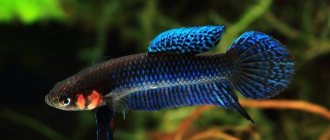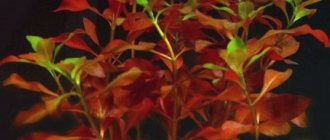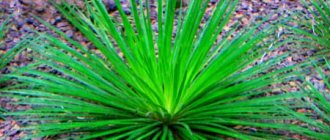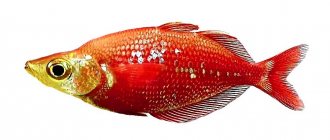An aquarium serves as an excellent decoration for your home interior. Fish and other aquatic pets live comfortably among stones, twigs and thickets. People often buy artificial plants, but real grasses look best in water. Aquarists sometimes purchase Ludwigia for artificial reservoirs.
There are only about 75 species of the ludwigia plant.
Description and habitat
Ludwigia is a member of the Onagricaceae, or Fireweed, family. The plant is represented by annual or perennial herbs, less often shrubs. It received its name in honor of the German botanist and physician Christian Gottlieb Ludwig, who was one of the early opponents of Carl Linnaeus.
Ludwigia can be found in tropical and subtropical areas. It is rich in Central and North America. The grass is also found in humid areas of Asia and Africa. The plant inhabits ponds, rivers and lakes. Under natural conditions, Ludwigia can interbreed with other types of herbs.
A representative of the flora is able to exist not only in water. Many of its varieties grow in dry areas.
The ornamental plant has an elegant appearance . Straight stems reach a height of 30−50 cm. Branched shoots are a little harsh. They are covered with simple leaflets arranged oppositely or alternately. The leaf blades are narrow, light green in color. Under favorable external conditions, they acquire a red-brown color. The shape and size of the leaves may vary among different species of Ludwigia. Yellow or greenish flowers with four petals form above the water surface.
The most common varieties of Ludwigia found in aquariums are creeping, arched, and swamp.
Residents of some countries grow grass as a fodder plant. Ludwigia is used in folk medicine and the food industry. There are varieties that are used in textile production: a yellow dye is made from the plant for dyeing fabrics.
In aquarium keeping, Ludwigia is a decorative element. Although this grass has a wide variety of species, it cannot be called widespread. In different countries, aquarists can purchase only a few varieties of this plant.
Ludwigia thrives in greenhouses and paludariums with high humidity levels. Specimens taken from the aquarium are planted in soil watered with water. In such conditions, the grass forms aerial shoots, which are transplanted into a substrate with garden soil, humus and sand. Terrestrial specimens easily tolerate flooding. They quickly adapt to new conditions and resume their growth.
Some grow Ludwigia not only for their aquarium, but also for sale. For bushes, select shallow containers with water, which should contain only the roots of the plants.
Suitable conditions for development
To maintain an aquarium Ludwigia plant, you need to select nutritious soil. It grows well in medium silted substrate. It is necessary to introduce clay balls into the new soil, which serve as fertilizing. For grass, fine gravel is suitable, the layer of which should be 3-4 cm. Large particles of ludwigia can injure its weak and delicate root system.
Water should have an acidity of 6.5−7 pH and a hardness of 5−6 dH. Some species of Ludwigia can develop normally in harder water. The aquatic environment should be kept clean as this grass is very sensitive to contaminants. Otherwise, fouling and plaque will appear on the leaves of the bushes.
Water temperature parameters for Ludwigia:
- acceptable values: +16−29 degrees;
- optimal indicators: +22−27 degrees.
At low temperatures, the plant's growth may slow down. It can also shed leaves and even get sick.
An aquatic pet must be provided with at least 12 hours of daylight. For the aquarium, it is necessary to organize bright lighting, which has a beneficial effect on the development of ludwigia and prevents it from becoming overgrown with algae. Natural light accelerates metabolic processes in the plant and improves photosynthesis. If direct sunlight rarely hits the side of the aquarium, then it is necessary to purchase incandescent and fluorescent lamps. Artificial lighting must be used in cloudy weather.
Ludwigia will benefit from mineral supplements in small quantities. A sufficient amount of elements causes the leaves on the bushes to become brighter, and in some species they acquire a dark red tint.
Important content details
Although housing conditions vary between species, there are a number of general points that are important to consider.
- Lighting. Without exception, all plant species love light. When setting up an aquarium, it is important to install sufficiently powerful lamps. It is also impossible not to mention the daily portion of natural light, which is an important source of healthy and active growth. With a lack of lighting, Ludwigia quickly loses its brightness, becoming inconspicuous and pale.
- Water purity. If you plan to place these plants in the aquarium, take care of such important things as an aerator and filter. All varieties suffer from turbidity and dirt in the water, and when the level of carbon dioxide increases, they can die. In addition to filtration and aeration, change the water in the aquarium weekly - by about a quarter or a third. Otherwise, the algae will not live long, even if it is an unpretentious and hardy species.
Ludwigia for aquariums is one of those plants that give the widest scope for imagination and the creation of a truly unique aquarium design. The variety of species allows you to choose exactly the variety that will fit into the aquatic interior. The most common types are unpretentious and are perfect even for beginner aquarists. More exotic varieties will be the ideal solution for experienced aquarists who want to diversify and improve their aquatic kingdom. Once you become familiar with the characteristics of different species, you can successfully keep algae in an aquarium environment for many years.
Return to content
Popular varieties for the aquarium
The plant amazes with its diversity. There are about 75 species of Ludwigia worldwide, including artificially bred varieties. Varieties may differ in bush size and leaf color.
Most often, aquarists purchase the following species:
- Bolotnaya. It has the longest and most branched stem among all its fellows. The leaves are light olive green above and reddish-purple below. Under optimal conditions it can bloom. This variety easily tolerates transplantation, breeding and changes in the parameters of the aquatic environment. The plant has two subspecies - Ludwigia angustifolia and variegata.
- Glandulose. This interesting grass is also called glandular grass. Glandulose has a thick stem that grows upward and does not lie on the surface. The leaf blades are distinguished by their elongated, pointed shape and pinkish-red hue. Underwater the color is less bright. This variety is characterized by slow growth. It is important to create comfortable conditions for glandulose, since it does not tolerate fluctuations in water and sheds its leaves at the slightest change.
The duration of daylight for Ludwigia should be at least 12 hours. - Arc-shaped. This type is also called arcuata. This Ludwigia is ideal for creating a tropical corner. The plant has thin elongated leaves with a bright color that changes from green to brown-red. If you increase the water hardness, then the color of the bush becomes more intense.
- Oval, or ovalis. An aquatic pet from East Asia has a straight stem of a red hue, which is covered with elongated oval leaves. The lower part of the plates is red, and the upper part can vary from dark green to reddish. The leaves on the stem are arranged in the form of a blossoming bud. The original appearance makes ovalis an excellent solution for decorating an aquarium. The plant is characterized by a low growth rate. It needs to be fertilized regularly, as due to a lack of minerals it begins to rot.
- Creeping. Keeping Ludwigia in an aquarium does not cause problems even for beginners, which is why this variety is considered the most popular. It has oval leaves that are green on top and reddish-purple underneath. Grass grows well throughout the year if the necessary conditions are provided for it. A subspecies of creeping ludwigia is ruby. Beautiful leaf blades are characterized by an intense scarlet color. Bright bushes look original against the background of aquarium greenery.
Based on crossing creeping and swamp ludwigs, breeders developed a hybrid variety. It easily adapts to aquarium conditions and is characterized by rapid growth. The hybrid look has good branching, which can be enhanced by regular trimming. The plant is covered with oval leaves with a glossy surface. The upper part of the plates can be olive or bright green, and the lower part can be reddish or pale greenish.
Who is responsible for the color red?
The color of plants depends on special chemical elements. These pigments not only determine color, but are also responsible for the life cycle of higher vegetation. Chlorophyll, for example, reflects green rays. That's why this element is green.
It is not surprising that it gives a green tint to all organs in which it is present. But it is not the only coloring substance. Flavonoids, subdivided into flavonones and flavones, are also responsible for the variety of colors.
They protect plant tissues from the harmful effects of ultraviolet radiation. This protective function is provided by the absorption of light in the short-wave range.
The greater the concentration of ultraviolet radiation in a light beam, the greater the amount of flavonoids is synthesized. And with an increase in the content of these elements, the leaf plate becomes redder.
Since ultraviolet light does not penetrate into the aquatic environment of the aquarium, the theory with flavonoids does not work.
Firstly, the flow of ultraviolet radiation is blocked by the protective shell of fluorescent lamps.
Secondly, this type of electromagnetic flux is absorbed by water. According to recent studies, the red color is the responsibility of carotenoids.
Depending on the plant species, there are 2 main spheres of influence of orange, yellow and red plant pigments:
- Shade-tolerant crops. For Vallisneria, Bolbitis or Anubias, for example, they act as additional light-harvesting elements. They absorb rays in the part of the spectrum in which chlorophyll is not particularly strong. But due to the fact that the concentration of carotenoids in this range is negligible, the transformation from green to red does not occur.
- Photophilous species. This group includes aquarium cultures of all shades of red, from pale pink to purple and red-violet. The carotenoids contained in these plants stop the oxidation of chlorophyll. This is possible under the influence of intense lighting, which provokes an excess of energy. In turn, this chemical reaction leads to the destruction of the green pigment. At this moment, carotenoids come to the fore, taking energy surpluses and transforming the resulting energy into heat.
Thanks to these mechanisms, invisible to the naked eye, most aquarium cultures turn red when they reach the surface of the water.
Other types
Ludwigia has other interesting varieties. The Senegalese, or Mexico, species has recently entered the aquarium market. It attracts attention with its red-brown oval leaves, which have a spotted pattern on them. Super red, which has several subspecies, is characterized by a rich scarlet color.
Diamond is considered difficult to care for because it can quickly die due to changes in the aquatic environment. This variety is recommended to be purchased only by experienced aquarists. But beginners can safely choose marilia. Greenish-yellow Ludwigia is easy to care for and adapts well to the conditions of artificial reservoirs. The plant is distinguished by a long and thin stem, thanks to which it beautifully spreads across the water.
Inclinata, which has 2 popular subspecies, is considered successful in breeding
- Cuba. When a plant is transplanted into an aquarium, its oval leaves become elongated and narrowed, and the green color changes to marble with a copper tint.
- Tornado. This variety is smaller than a cube, but has attractive spiral-shaped leaves of a greenish color, turning into red-purple.
Another original variety of Ludwigia is mato grosso. The underwater pet lies beautifully on the surface due to its thin and soft stem. The leaves are characterized by a smoky green color.
Compatibility with fish and other plants
Like any plant, ludwigia should be combined with certain underwater inhabitants.
Experts do not recommend planting a representative of the flora in an aquarium with large or small fish that like to dig in the soil. This can lead to serious damage to the plant's root system, which will negatively affect the overall condition of the bush.
Various types of herbs are used in aquadesign. When choosing green neighbors, you should remember that ludwigia needs bright lighting, which can have a bad effect on the condition of other plants. It is also necessary to select crops that do not interfere with the penetration of light into the tank. If Ludwigia is present in the container, then you should immediately abandon voluminous plantings with large leaves.
A herbaceous pet benefits not only through the active production of oxygen. It also serves as an excellent shelter for schools of fry. The plant is useful for many types of fish suffering from a lack of vitamins.
At water temperatures above 8C, Ludwigia leaves become brighter.
Reproduction and transplantation
The aquarium plant Ludwigia reproduces well in artificial conditions. You can fill the tank with attractive bushes using cuttings.
Using sharp scissors, carefully cut off the tops of the stems. Cuttings 8-10 cm long are immediately placed in the ground. With the correct organization of light and other conditions, the shoots quickly take root, releasing roots. For young specimens, you should select a nutrient substrate or a special substrate with the elements necessary for growth and development. To get a bush with a dense crown, a couple of leaves are torn off from a healthy stem. After some time, new shoots will begin to grow from these areas.
Sometimes plants are replanted to change the decorative composition in the aquarium. This procedure does not cause a negative reaction in Ludwigia. The bush is replanted with roots. In order for the grass to quickly take root in a new place, when diving, pinch off the tip from the root.
To propagate ludwigia, you need to separate cuttings at least 10 cm in length.
Use in aquadesign
Ludwigia is often used in aquatic design as an accent. The varieties with scarlet leaves look especially impressive. If you group several plant cuttings together, you can create a red-green forest in the background of an artificial pond. You can also place the bushes in the middle part of the container if you trim them regularly. To obtain dense thickets, cut off the side shoots. If you cut off the bottom part, then the ludwigia will grow upward.
In strong light the plant is placed in the foreground, but it will have to be trimmed frequently to make it look spectacular. This option is often used by experienced aquarium owners. It is not recommended to plant bushes in shaded areas of the tank, otherwise they will stop growing and disappear over time.
With Ludwigia you can create an original and unique aquarium design. There is a suitable plant variety for any aquatic interior. Once you become familiar with the characteristics of Ludwigia species, you can successfully grow it in an aquarium for many years.











